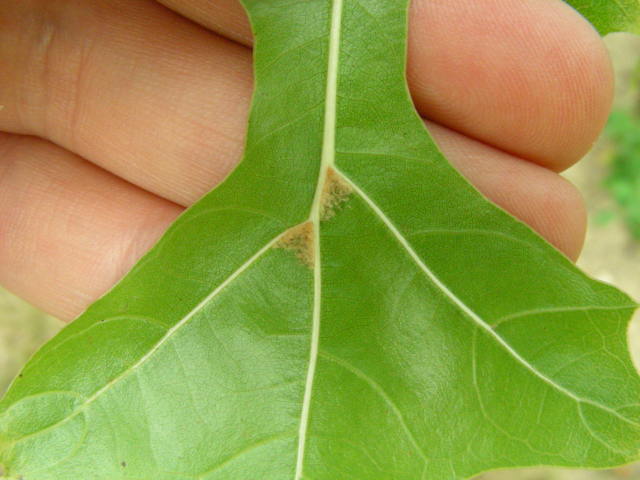QuestionQUESTION: I have a young pin oak (10 years). On the underside of most leaves is what appears to be a fungus or mold, light tan in color, located at the junction of the veins. This appears shortly after the leaves emerge, such that most leaves do not form completely, and in some cases the terminal bud of a branch is killed.
This is the second year that this has affected the tree and I am very concerned that the tree will not survive another season.
I have not been able to find any pathogen that matches this description, nor any means of treating it.
Thanks for any advice.
ANSWER: A picture would help a lot. Please attach a picture to the question.
One of the pest problem on pin oak is an insect called a vein pocket gall which sort of like what you describe. These galls are caused by the larval (maggot) stages of very small flies called midges. Vein pocket galls are elongate swellings that occur along mid- and lateral leaf veins of scrub and pin oaks. The process begins when the unfolding leaves begin to flatten out. At this time, the small midge lays its eggs. The tiny maggots move to the veins and begin to feed. In a few days they are covered by gall tissue and complete development by mid-spring. The mature larvae drop to the ground and remain there over the winter. Here is a picture of this. http://extension.missouri.edu/adair/veinpocketgall.aspx
http://www.ento.okstate.edu/ddd/insects/veinpocketgall.htm
---------- FOLLOW-UP ----------
 Pinoakleafback
Pinoakleafback
QUESTION: Thanks for the quick reply! I've attached a picture showing the back of the leaf. Every leaf has this pattern of...whatever, right at the junction of the veins.
I don't see anything unusual on bark or twigs, no scales or galls. just this, on the leaves. No leaf is able to grow to complete size, and you can also observe that the color is a little off.
Thanks again.
AnswerThanks for the picture. it is not the vein pocket gall. Looks like possibly a mite. I looked at some trees here and did fine these on some leaves and none on others all healthy leaves. Some oak species have these hair like growths on the under side and it could be normal. In any case I do not think this is your problem. I think it maybe a nutrient problem or possibly the roots are not growing out from the ordinal rootball. And become root bound.
Some times when a tree is planted in heavy clay soil the planter will dig a hole just the size of the rootball and sides of the hole during the digging will be smooth and form almost an under ground pot. When this happens the roots can not grow out into the surrounding soil and the tree can not get enough water and/or the pot will hold water drowning the roots.
Shade tree decline is a complex disease situation since the cause frequently cannot be traced to one single factor. Typically, one or more primary stresses cause the health of a tree to deteriorate, and then secondary pathogens and/or insects contribute to further decline. Determining causes of decline requires careful examination of the tree and growing site as well as knowledge of the tree's history. Even then, diagnosis may be difficult because the original stress may be obscure or no longer present. Trees most commonly affected are Norway and sugar maples, ash and oaks (particularly pin oaks).
There are several symptoms that may indicate decline. Early symptoms can include: late spring flush, a decrease in twig and stem growth, and premature fall coloration and leaf drop. As stress continues, foliage may appear small and pale in color. Water sprouts may grow from the branches and trunk.
Thinning in the upper crown foliage becomes evident as twigs die back. Larger branches die as the decline progresses. Heavy seed formation may be another indication of decline.
Also the soil may not be a good soil for pin oak and needs a little help. I would first try fertilizing the tree with 10-10-10 fertilizer scattered around the tree out say two feet from the trunk at the rate of 1 lb of fertilizer per inch of trunk diameter scattered around the tree and watered in good. Apply the fertilizer just before a rain storm and you will not need to water.
This fertilizer should encourage root growth and overcome the root bound problem. Treating the tree with an insecticide or fungicide is not needed since the problem is more of a root system problem rather than an insect or disease. The fertilizer should work--I would apply it now and again in the spring.






